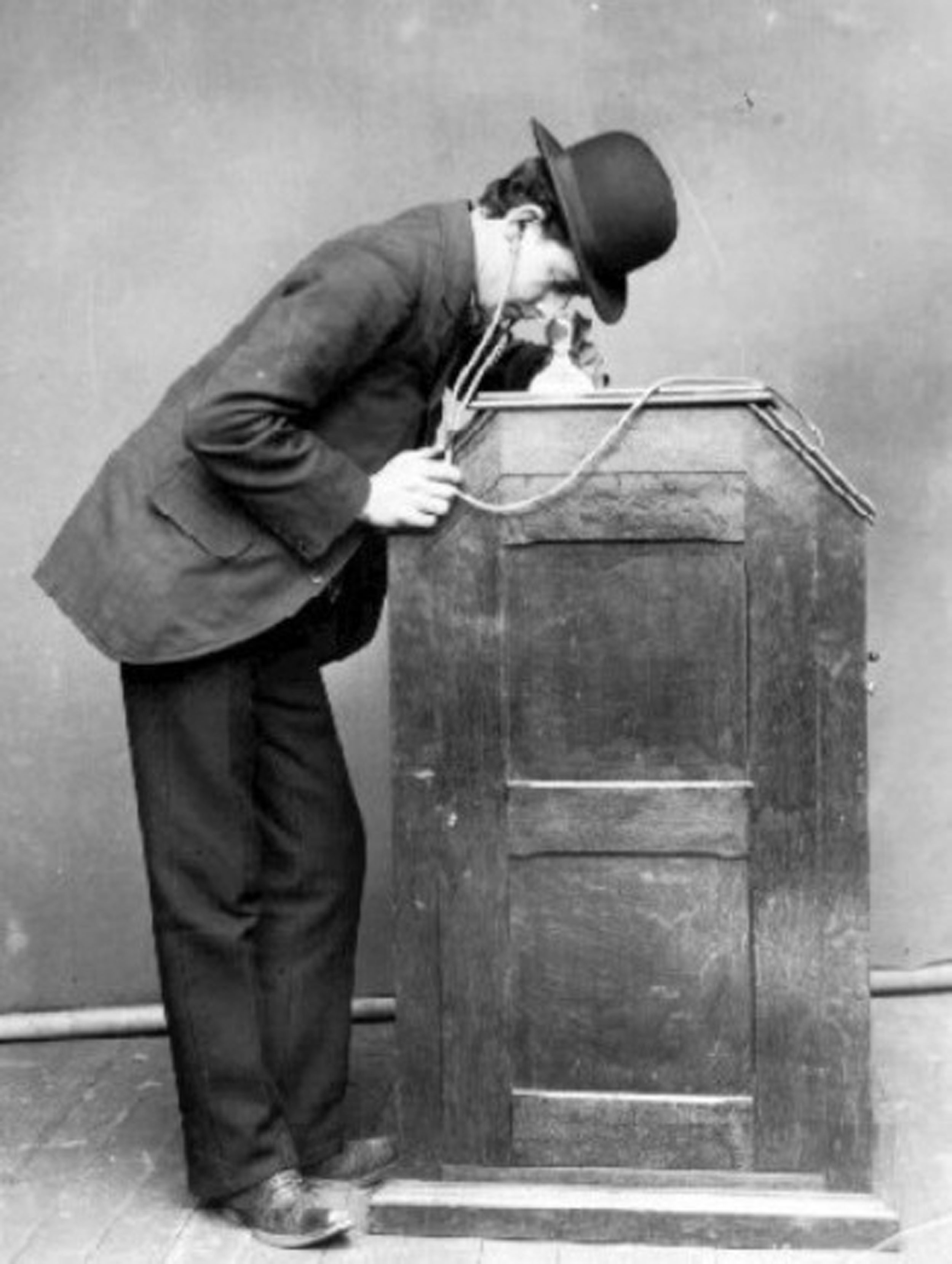
Thomas Edison invented the Kinetoscope which was an early motion picture device that was designed for films that had to be viewed by one individual at a time through a peep-hole viewer window at the top. Although it is not a movie projector it created the illusion of movement by conveying a strip of film bearing a sequence of images over a light source with a high speed shutter. It was largely developed by William Dickson between 1889 and 1892. Dickson and his team later on devised the Kinetograph which was a motion picture camera for in-house experiments and eventually, commercial Kinetoscope presentations.
Lumiere Brothers (Arrival of a train, 1895)
 A 50 second silent, black and white short film, showing a steam train coming into a station in France. It consists of a single, unedited shot illustrating an aspect of everyday life. There are no intentional camera movements and consists of one continuous real-time shot. As this short film was one of the first times moving pictures were shown to large audiences, urban legend says that the audience viewing the film ran out screaming as they believed a real train was coming towards them.
A 50 second silent, black and white short film, showing a steam train coming into a station in France. It consists of a single, unedited shot illustrating an aspect of everyday life. There are no intentional camera movements and consists of one continuous real-time shot. As this short film was one of the first times moving pictures were shown to large audiences, urban legend says that the audience viewing the film ran out screaming as they believed a real train was coming towards them.
This is an example of in camera editing as the camera had to start and stop recording for each shot and this formed the film.
Sergei Eisenstein and Montage editing
Born on Jan 23, 1898 in Riga, Latvia, Sergei Mikhaylovich Eisenstein was to become one of the most world-renowned filmmakers of the first half of the 20th century. Eisenstein was of Jewish descent through his paternal grandparents.Eisenstein's first film, the revolutionary "Strike," was produced in 1924. He proposed a new editing form, the "montage of attractions". In which independent from the action, would be presented not in chronological sequence but in whatever way would create the maximum psychological Impact. This first really appeared in the film 'Strike' in 1925. this was a series of fast edits that shows the audience whats going on in a short about of time and then montage has been adapted and used all over the media industry. A montage is the technique of selecting, editing, and piecing together separate sections of film that juxtapose each other to form a single film.
Montage Clip
In this clip we used our knowledge of Eisenstien's montage of attractions to create this clip.The clip above is my montage edit. I had done this as a comedy style montage more than a serious montage in comparison to other more serious montages i.e. the rocky montage. I have made this to show that i understand the principle of montage editing and telling a story without dialogue just visuals and fast cuts. In the rocky montage you see him training, in my montage we also did training, but we added comedy to it by making the character in it a weakling.
Apocalypse Now and Manipulation of diegetic time and space
The clip above is opening scene of Apocalypse Now. Manipulation of Diagetic Time and Space is either a dream sequence or a flash back.In this opening its a flash back, the main character is lying
on a bed remembering Destroying a forest in Vietnam. There is a
'Trigger' for this and that is the ceiling fan in the room that he is in, linked in with the helicopter blades spinning. A brief Synopsis of the film: In Vietnam in 1970, Captain Willard (Martin Sheen) takes a perilous and
increasingly hallucinatory journey upriver to find and assassinate Colonel
Kurtz (Marlon Brando), a once-promising officer who has reportedly gone
completely mad. In the company of a Navy patrol boat filled with
street-smart kids, a surfing-obsessed Air Cavalry officer (Robert
Duvall), and a crazed freelance photographer (Dennis Hopper), Willard
travels further and further into the heart of darkness.
We decided to do a dream sequence of a person falling asleep that is revising for an exam and he dreams about being late for the exam and when he gets to the room he sees himself asleep at the desk.This taught me a lot about this editing style because i got the to learn about continuity editing at the same time
City Of God and fast paced editing
The film is very quickly edited to show the face paced life in Rio De Janeiro. The new age audience who would watch this would have short attention spans therefore this quick pace editing accommodates to the target audience.
Bibliography
http://www.videouniversity.com/articles/the-art-of-film-and-videos-editing-part-3/
http://www.elementsofcinema.com/editing/montage.html
http://en.wikipedia.org/wiki/Montage_%28filmmaking%29
Grammar of the film language. By Daniel Arijon
No comments:
Post a Comment